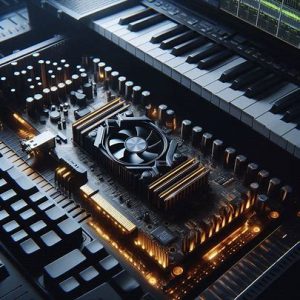 Music isn’t just about sound anymore. Visual storytelling has become a huge part of a musician’s toolkit. Whether it’s electrifying stage visuals, eye-catching music videos, or smooth livestreams, artists today need graphics power to match their creative vision. The days when only gamers talked about GPUs are long gone. Now, musicians are joining that conversation.
Music isn’t just about sound anymore. Visual storytelling has become a huge part of a musician’s toolkit. Whether it’s electrifying stage visuals, eye-catching music videos, or smooth livestreams, artists today need graphics power to match their creative vision. The days when only gamers talked about GPUs are long gone. Now, musicians are joining that conversation.
Many artists rely on real-time visuals to complement their live performances. VJs sync graphics with beats, DJs mix audio with reactive visuals, and independent artists edit music videos themselves. To make all this work seamlessly, musicians need affordable Full HD GPUs that can handle the pressure. The RTX 5060 Ti fits that need, offering enough performance to power high-quality visuals without costing as much as high-end gaming cards.
The Role of GPUs in Modern Music Production
While the CPU handles most of the heavy lifting for audio processing, the GPU takes charge when it comes to anything visual. Think of real-time light shows, motion graphics, or even animated cover art. These visuals must be rendered quickly and in sync with the audio. Lag or dropped frames can ruin the vibe of a live performance or reduce the quality of a video. That’s where the power of the RTX 5060 Ti becomes clear. It’s designed to keep things smooth, fast, and visually appealing.
Why the RTX 5060 Ti is a Game-Changer for Musicians
What makes the RTX 5060 Ti such a good choice? First off, it’s built with NVIDIA’s latest architecture, which means it can handle 1080p visuals at high frame rates. Whether you’re running Resolume, TouchDesigner, or VJ software, you get stable performance. Plus, its support for modern video encoding tools helps musicians edit videos faster, stream in higher quality, and keep their content looking crisp.
Music producers who dabble in video editing or live streaming will love the boost in render speeds. Exporting videos in Adobe Premiere Pro or DaVinci Resolve gets a noticeable lift thanks to hardware acceleration. That means less time waiting—and more time creating.
Streaming, Overlays, and Real-Time Performance
Livestreaming has become a huge platform for musicians to connect with fans. But livestreams are more than just a webcam and a mic. They often include animated overlays, transitions, visual effects, and background loops. All of these demand GPU power. A weak GPU can lead to dropped frames, low resolution, or audio-sync issues. The RTX 5060 Ti ensures everything runs smoothly—even if you’re using OBS with multiple sources, chroma key effects, and live video filters.
This card also supports NVIDIA Broadcast, a tool that enhances your stream using AI-based features like background blur and noise removal. These tools make your stream look and sound more professional without needing extra gear.
Visuals for the Stage and Studio
Live music shows are getting more visual by the day. Artists use projection mapping, 3D elements, and synced visuals to turn performances into experiences. VJ software often requires strong GPU support to keep visuals in sync with the beat. The RTX 5060 Ti can handle this level of real-time demand, making it perfect for musicians who run their own shows or work with small production teams.
In the studio, musicians can now add animated visuals to tracks, enhancing social media clips or creating short‑form content for platforms like Instagram Reels or TikTok. Whether you’re editing a music video or layering effects on a motion loop, a GPU like the RTX 5060 Ti will get you there faster and more reliably. For artists exploring AI-enhanced audio alongside visual tools, check out Coke Weed’s piece on Exploring AI‑Powered Sound Design.
Final Thoughts: Power Meets Creativity
Musicians are no longer just sound creators—they’re multimedia artists. With platforms like YouTube, Twitch, and TikTok shaping how music is consumed, visuals have become essential. A strong GPU like the RTX 5060 Ti helps musicians keep up with visual trends, produce professional content, and maintain the flow of live shows.
While CPUs and audio interfaces still matter, it’s time for artists to consider what their graphics card can do. When visuals matter—and they always do now—musicians need the right tools to make them shine.

